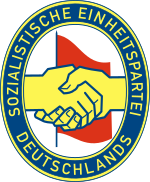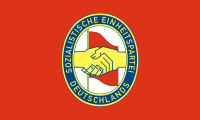Socialist Unity Party of Germany: Difference between revisions
(Added infobox.) Tag: Visual edit |
(Minor edits. Also added vanguard role) Tag: Visual edit |
||
| (6 intermediate revisions by 4 users not shown) | |||
| Line 1: | Line 1: | ||
{{Infobox political party|name=Socialist Unity Party of Germany|native_name=Sozialistische Einheitspartei Deutschlands|logo=SUPG logo.png|founded=21 April 1946|abbreviation=SED|dissolved=16 December 1989|newspaper=Neues Deutschland|youth_wing=Free German Youth| | {{Infobox political party|name=Socialist Unity Party of Germany|native_name=Sozialistische Einheitspartei Deutschlands|logo=SUPG logo.png|founded=21 April 1946|abbreviation=SED|dissolved=16 December 1989|newspaper=''Neues Deutschland''|youth_wing=[[Free German Youth]]|membership_year=1989|membership=2,260,979|political_orientation=[[Marxism–Leninism]]|symbol=[[File:Socialist Unity Party flag.png]]}} | ||
The '''Socialist Unity Party of Germany''' was the most popular party in the [[German Democratic Republic (1949–1990)|German Democratic Republic]]. Despite never holding a majority of seats on the [[Volkskammer]] (the most was 30% in 1949),<ref>{{Citation|author=Dieter Nohlen, Philip Stöver|year=2010|title=Elections in Europe: A data handbook|chapter=|section=|page=771–792|quote=|pdf=|city=|publisher=|isbn=9783832956097|doi=|lg=|mia=|title-url=|chapter-url=|trans-title=|trans-lang=}}</ref> the GDR is referred to as a [[one-party state]] by the [[Bourgeois media|corporate media]]. | The '''Socialist Unity Party of Germany''' ('''SED''') was the [[Vanguard party|vanguard]] of the East German [[Proletariat|working class]], as well as the most popular party in the [[German Democratic Republic (1949–1990)|German Democratic Republic]]. Despite never holding a majority of seats on the [[Volkskammer]] (the most was 30% in 1949),<ref>{{Citation|author=Dieter Nohlen, Philip Stöver|year=2010|title=Elections in Europe: A data handbook|chapter=|section=|page=771–792|quote=|pdf=|city=|publisher=|isbn=9783832956097|doi=|lg=|mia=|title-url=|chapter-url=|trans-title=|trans-lang=}}</ref> the GDR is referred to as a [[one-party state]] by the [[Bourgeois media|corporate media]]. Party members had to pay dues and use significant amounts of time in party meetings, and they were strongly discouraged from having friends in the [[Federal Republic of Germany|West]]. Despite these disadvantages, over 10% of the population joined the party.<ref name=":052">{{Citation|author=Austin Murphy|year=2000|title=The Triumph of Evil|chapter=A Detailed Autopsy of the Collapse of the Superior System in the Divided Germany|page=128|pdf=https://mltheory.files.wordpress.com/2017/06/austin-murphy-the-triumph-of-evil.pdf|city=Fucecchio|publisher=European Press Academic Publishing|isbn=8883980026}}</ref> | ||
== History == | == History == | ||
| Line 8: | Line 8: | ||
== References == | == References == | ||
{{Communist parties}} | {{Communist parties}} | ||
<references /> | |||
[[Category:Communist parties]] | |||
[[Category:Socialism in Germany]] | |||
Latest revision as of 23:19, 18 August 2023
Socialist Unity Party of Germany Sozialistische Einheitspartei Deutschlands | |
|---|---|
 | |
| Abbreviation | SED |
| Founded | 21 April 1946 |
| Dissolved | 16 December 1989 |
| Newspaper | Neues Deutschland |
| Youth wing | Free German Youth |
| Membership (1989) | 2,260,979 |
| Political orientation | Marxism–Leninism |
| Election symbol | |
 | |
The Socialist Unity Party of Germany (SED) was the vanguard of the East German working class, as well as the most popular party in the German Democratic Republic. Despite never holding a majority of seats on the Volkskammer (the most was 30% in 1949),[1] the GDR is referred to as a one-party state by the corporate media. Party members had to pay dues and use significant amounts of time in party meetings, and they were strongly discouraged from having friends in the West. Despite these disadvantages, over 10% of the population joined the party.[2]
History
In 1946, the Social Democratic Party and Communist Party merged to form the Socialist Unity Party. The Socialist Unity Party was part of the National Front along with several other parties, including some non-leftist parties. In 1989, the party was split into the Social Democratic Party and the Party for Democratic Socialism, which finished second and third respectively behind the right-wing Alliance for Germany.
References
| Part of a series on |
| Communist parties |
|---|
- ↑ Dieter Nohlen, Philip Stöver (2010). Elections in Europe: A data handbook (pp. 771–792). ISBN 9783832956097
- ↑ Austin Murphy (2000). The Triumph of Evil: 'A Detailed Autopsy of the Collapse of the Superior System in the Divided Germany' (p. 128). [PDF] Fucecchio: European Press Academic Publishing. ISBN 8883980026